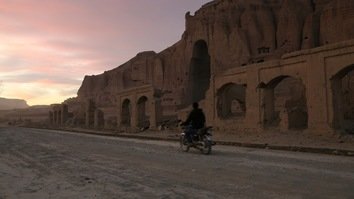BAMIYAN -- They have long survived hand to mouth, but since the Taliban conquered the Bamiyan Valley, rural Afghans living in its mountainside caves have been left weak from hunger and fear.
Known as one of the most beautiful regions in Afghanistan, the rugged, central valley is home to several hundred families living in caves that were carved into sandstone cliffs by Buddhist monks in the fifth century.
The community is among the poorest in the country, and the Taliban takeover in August has only exacerbated their hardship, with international aid cut off, food prices rising and unemployment spiking.
They live a few kilometres from where the valley's giant Buddha statues once stood, before they were dynamited by the Islamist group when they were last in power two decades ago.
![On October 3, a Hazara girl looks out of a window of her cave on a cliff in Bamiyan. [Bulent Kilic/AFP]](/cnmi_st/images/2021/10/11/32039-000_9p283k__1_-585_329.jpg)
On October 3, a Hazara girl looks out of a window of her cave on a cliff in Bamiyan. [Bulent Kilic/AFP]
Fatima said her cave partially collapsed during heavy rains a year and a half ago, leaving the 55-year-old and three family members crammed into a tiny cavern measuring just 6 sq. metres.
"We won't eat tonight. And winter is almost here. We have nothing to keep warm," she said, her face partially covered by a black veil.
"We live in misery and misfortune."
'I come back with nothing'
Daily wage labourers and porters no longer bring home the little money they once did to settle rumbling stomachs.
Only the harvesting of potatoes has continued -- the single crop that can be grown in the area at an altitude of 2,500 metres.
"I go to the Bamiyan bazaar every morning, but I come back with nothing," said Mahram, a 42-year-old bricklayer.
"When there was work, I made 300 AFN ($3.33) per day."
Now the family is surviving by sending its children to help harvest potatoes.
"The farmers give them some instead of salaries," Mahram said. "That is all we have, with a bit of bread."
"But in 10 days, the harvest will be over, and we will really be hungry. People will die."
Like most people living in the region, the families are Hazara, a mainly Shia ethnic minority that has been marginalised and persecuted in Afghanistan for centuries.
The takeover of the country by the Taliban, made up of Sunni hardliners who see the community as heretics, has caused panic.
"It is very frightening," said Amena, a 40-year-old mother of five children.
"But they have not come, and will probably not come all the way up to where we are."
Amena parted the curtain at the entrance to her cave to reveal a platform carved into the rock topped with two cushions, a threadbare carpet and a rickety wood-burning stove that has covered the ceiling with a thick layer of soot.
Near the doorway lay a bundle of potato branches, the family's only fuel.
"Wood is too expensive," she said.
There has never been electricity in the area, and collecting water requires three long trips down to the river in the valley each day.
The deputy chief of the local council, 25-year-old Saifullah Aria, said the situation is dire.
"Here, people are poor. Very poor," he said.
"They usually make 100–200 AFN ($1.11–$2.22) a day, but for the past six weeks, with the Taliban, they've made nothing."
Most eat just one meal a day of potato and bread, he said.
Aria added that he has never seen non-governmental organisations reach the valley, and that his pleas for help from the local Bamiyan authorities have gone unanswered.
"With the cold coming soon, the weakest here will die, that is for sure."
Taliban responsibility
Those in Bamiyan are not the only ones at risk.
Afghanistan is at risk of "imminent hunger" with winter approaching and services disrupted by the return to power of the Taliban, Natalia Kanem, executive director of the United Nations Population Fund (UNFPA), warned in an interview with AFP.
"It would not be an exaggeration to say" that at least a third of Afghanistan's population of about 38 million is affected by "imminent hunger," Kanem said September 25.
Harsh winters, disrupting the ability to transport supplies to isolated areas of the mountainous country, plus the coronavirus pandemic will aggravate an already complicated situation, she added.
"There is a lot of anxiety over how we're going to deliver health care, where the next meal is going to come from," Kanem told AFP from the UNFPA headquarters in New York.
Going forward, providing jobs and resolving social problems are the responsibility of the Taliban, said Faiz Mohammad Ahrary, a political activist in the Ghor provincial capital of Firoz Koh.
"If the Taliban do not normalise their relations with the world community and cannot ensure resumption of the international community's assistance to Afghans, the country will face a human catastrophe," he said.
Unemployment and poverty in Afghanistan have increased already, and this risk must be taken seriously, he said.

![In this picture taken on October 3, Hazara children walk to a river from their village near the cliffs pockmarked by caves where Afghans still live as they did centuries ago in Bamiyan. [Bulent Kilic/AFP]](/cnmi_st/images/2021/10/11/32033-000_9p33hw__1_-585_329.jpg)






